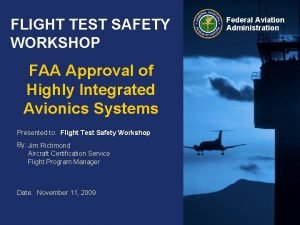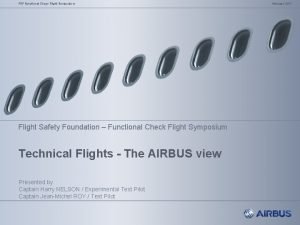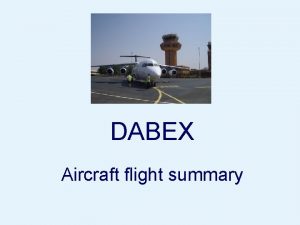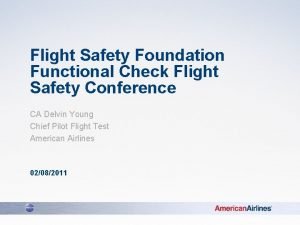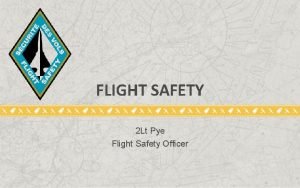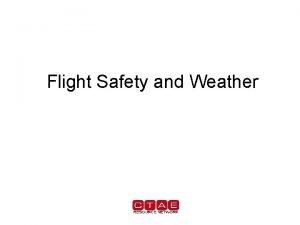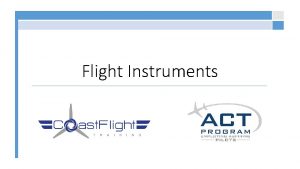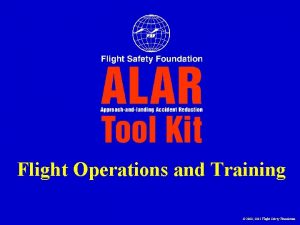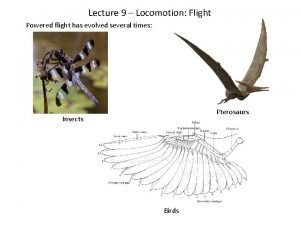Flight Safety Flight Safety An understanding of the













- Slides: 13

Flight Safety

Flight Safety An understanding of the causes of actual and potential accidents and incidents will most likely improve a pilot’s ability to operate safely. Better training methods and a focus on continuing education of glider pilots will have a positive effect on reducing accidents and incidents

Flight Safety Incorrect WEIGHT AND BALANCE has been highlighted as a particular problem affecting flight safety. Pilots need better awareness of the importance of getting the weight and balance correct. Apart from knowing how to make weight and balance calculations and to make proper use of them, a student needs to know other possible causes of imbalance situations. The FAA GFH discusses problems associated with CG forward of forward limit, and with CG aft of aft limit.

Number of Soaring Accidents

Flight Safety Look at glider accidents (fatal and non-fatal) reported to the NTSB

Major Accidents Launch PT 3 events – Intentional vs unintentional release Mid-air collisions – Glider and Towplane collide turning final – Airplane collides with Towplane towing Glider – Two Gliders collide during cruise flight (contest) – Two Gliders collide while thermaling (contest) – ‘ 04 -1, ‘ 05 -0, ‘ 06 -1, ‘ 07 -0, ‘ 08 -2, ‘ 09 -0, ‘ 10 -4

Major Accidents Crashed Gliders – Glider crashed in mountainous terrain – Glider crashed in field Approach and Landing – Major thrust for the past few years

Landing Accidents Hit object on approach -- 10 Stall/spin on approach -- 1 Hit object on ground -- 3 Hard landing -- 3 Land short (undershoot) -- 0 Land long (overshoot) -- 1 Landing accidents have accounted for approximately 60% of the total number of accidents for decades. WHAT LESSONS CAN BE LEARNED FROM THIS?

Angles vs Distance Do you find it easy to judge a straight line distance – say 1, 000 feet? Do you find it easy to judge an angle – say 30 degrees? Can you easily perceive when an angle changes? Can the ability to see instantly an angle which is changing help us as pilots?

Flight Safety SPRM – Single Pilot Resource Management Use ALL available resources to gain information Check list usage: – Pilot IMSAFE – Glider Rigging (Flight Manual) Pre-Flight (Flight Manual) Critical Assembly Check (SSF) Pre-Takeoff (Flight and Operations Manuals) Landing (memory) UNINTERRUPTED CHECKS

Scenario based training Use realistic scenarios to enhance pilot decision making skills – Ground instruction and class room discussions during primary and recurrent training – Flight instruction during primary and recurrent training

Generate Scenarios Start by generating a scenario – 2 -3 sentences that set the stage – A single event per scenario – Make it plausible – Pictures or videos can augment the text The list a set of discussion points – What factors influence the pilot's decision – What options does the pilot have – How should the pilot prioritize those options

Flight Safety Don’t be rushed Don’t assume Structured uninterrupted preparation
 Iraad definition project management
Iraad definition project management Flight test safety workshop
Flight test safety workshop Flight safety foundation
Flight safety foundation đặc điểm cơ thể của người tối cổ
đặc điểm cơ thể của người tối cổ Tỉ lệ cơ thể trẻ em
Tỉ lệ cơ thể trẻ em Các châu lục và đại dương trên thế giới
Các châu lục và đại dương trên thế giới ưu thế lai là gì
ưu thế lai là gì Các môn thể thao bắt đầu bằng từ đua
Các môn thể thao bắt đầu bằng từ đua Tư thế ngồi viết
Tư thế ngồi viết Thẻ vin
Thẻ vin Cái miệng bé xinh thế chỉ nói điều hay thôi
Cái miệng bé xinh thế chỉ nói điều hay thôi Hình ảnh bộ gõ cơ thể búng tay
Hình ảnh bộ gõ cơ thể búng tay Mật thư anh em như thể tay chân
Mật thư anh em như thể tay chân Từ ngữ thể hiện lòng nhân hậu
Từ ngữ thể hiện lòng nhân hậu

